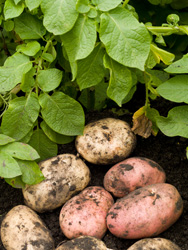Building defences against potato blight
One of the keys to success for a parasite is to interfere with the host's immune system. Potato blight is no exception in its ability to avoid destruction by chemically combating the plant's defences. P. infestans injects so-called effector proteins into the apoplast or spaces outside the membranes surrounding cells in the leaf tissue as it invades. These proteins inhibit plant enzymes. The fungus's other weapon is to inject them into the cell cytoplasm and nucleus where they manipulate the plant's immune system. The project, aptly named Effector targets ('Host target proteins of Phytophthora secreted effectors'), aimed to identify the protein effectors that cause the crippling of immune systems. The next step would be to unravel the secrets of their biological function and the cells they target in the plant. Co-immunoprecipitation (co-IP), a technique used to study protein-protein interaction revealed a candidate effector, AVRblb2, that is recognised by a gene that offers resistance against blight. AVRblb2 tinkers with the plant's physiology in various ways. It accumulates round the tip of the fungus's invading hyphae, causing increased susceptibility to infection. The project team also identified one of its target molecules – C14, a previously unknown defence enzyme. When the project team inactivated C14, the plant became more susceptible to blight. Manipulation of C14 can result in increased resistance to P. infestans and can therefore be used in biotech and breeding. Furthermore, the discovery of AVRblb2 and its action on haustoria stands to be translated into new opportunities for engineering durable disease resistance in crop plants.







